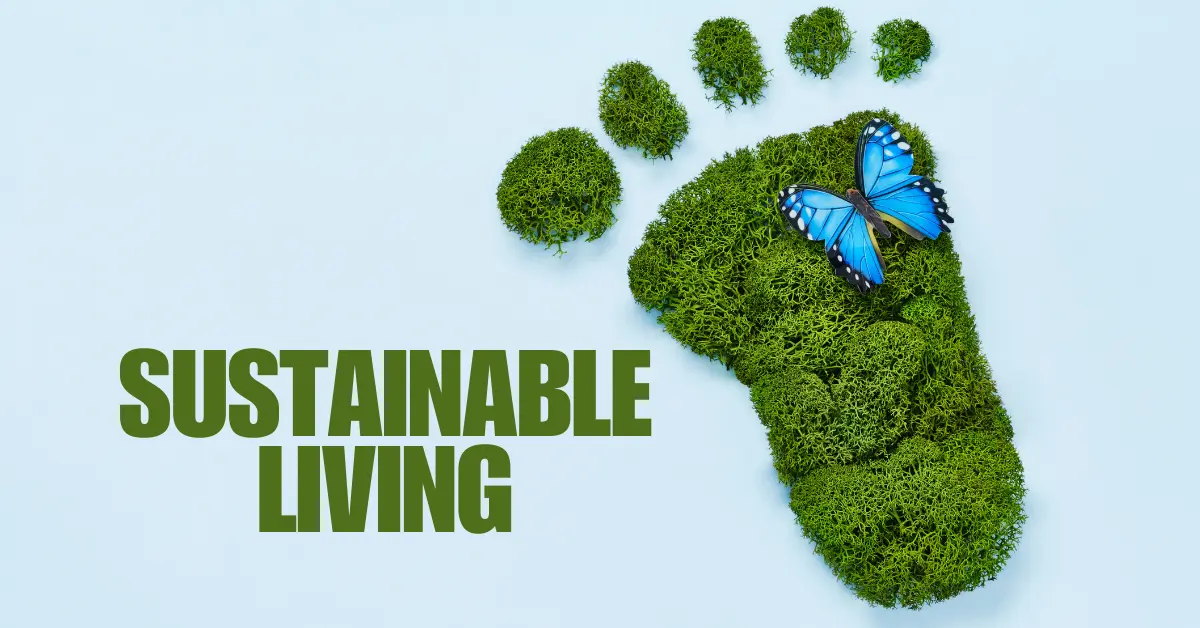In an era marked by environmental challenges and resource depletion, sustainable living emerges as a vital solution for a healthier planet and future generations. It encompasses mindful choices in daily habits, consumption, and resource management, aiming to reduce waste, conserve energy, and promote ecological balance. From adopting renewable energy to minimizing single-use plastics and supporting local, ethical businesses, sustainable living empowers individuals and communities to create lasting positive change.
We’ve put together this guide to help you create a more sustainable lifestyle one step at a time.
Benefits of Sustainable Living
Sustainable living isn’t just about helping the environment—it also offers many personal and community benefits.
1. Saves Money: Although eco-friendly choices like solar panels or energy-efficient appliances may cost more upfront, they save money over time by lowering bills. Living minimally—buying fewer high-quality items instead of disposable ones—also reduces expenses in the long run.
2. Improves Health: Sustainable habits often lead to better Health. Eating organic foods, avoiding harmful chemicals, and cutting back on processed products can reduce the risk of diseases like diabetes and heart issues. Activities like walking, biking, and gardening promote fitness and well-being.
3. Lowers Environmental Impact: A sustainable lifestyle helps protect the planet by reducing waste, conserving resources, and cutting pollution. Simple actions like recycling, using less energy, and choosing eco-friendly transportation make a big difference over time.
4. Enhances Life Quality: Sustainability promotes balance and intentional living. Focusing on experiences over possessions, decluttering, and connecting with nature can lead to a more meaningful and satisfying life.
5. Drives Positive Change: Sustainable living inspires others and helps build stronger communities. Advocating for green policies and supporting eco-friendly businesses contributes to a better future for everyone.
Every small effort adds up to create a significant impact!
Why Practice Sustainable Living in 2025?
Sustainable living is no longer an option—it’s a necessity. Here’s why you should make the shift:
1. Fighting Climate Change : Everyday actions like burning fossil fuels and deforestation contribute to global warming. By adopting sustainable habits like using renewable energy, driving less, and choosing energy-efficient appliances, you can help reduce greenhouse gas emissions and combat climate change.
2. Conserving Resources: Earth’s resources like water, minerals, and forests are limited. Simple steps like reducing waste, recycling, and using renewable energy can help preserve these precious resources for future generations.
3. Protecting Biodiversity: Human activities are driving many species to extinction. Sustainable practices like supporting conservation programs, planting trees, and choosing eco-friendly products can help protect ecosystems and the wildlife that depends on them.
4. Improving Health: Sustainable living often leads to better health. Eating organic foods, avoiding toxic chemicals, and choosing activities like walking or biking not only reduce your environmental impact but also promote physical and mental well-being.
5. Creating a Resilient Future: Sustainability prepares communities for challenges like natural disasters and economic disruptions. It fosters self-reliance and helps build a more secure future for everyone.
Small changes in your daily life can make a big difference. Start living sustainably today!
Your Ultimate Guide to Eco-Friendly Living as a Man
Sustainable living is about enacting lifestyle changes that contribute to resource preservation, minimizing our ecological footprint, and creating a healthier world for future generations. Men can change their everyday habits in meaningful ways to live more sustainably. A Complete Guide to Men’s Sustainable Living: Sustainable Living for Men
Sustainable Clothing Choices
1. Buy Less, Choose Wisely
- Minimalist Wardrobe: Curate a minimalist wardrobe to reduce consumption. Focus on versatile, high-quality items that last longer.
- Purchase Quality: Opt for durable clothing, especially for essentials like shoes, jackets, and jeans. Look for brands with a reputation for longevity.
2. Eco-Friendly Fabrics
- Organic Materials: Seek out clothes made from organic cotton, hemp, or bamboo, which use fewer chemicals and less water to grow.
- Other Recycled Fabrics: Clothing made from other types of recycled fabrics, such as polyester, can help cut waste and energy usage.
3. Second-Hand Shopping
• Thrift shops and online resale boutiques are a great way to have stylish items without the environmental detriment of fast fashion.
Energy Efficiency at Home
1.Smart Energy Usage
- LED lighting: Replacing Glowing bulbs with energy-efficient LED lights helps cut electricity use.
- Energy-Efficient Appliances: Buy appliances with a high-energy rating (A+++ or Energy Star). The same is true for refrigerators, washing machines, and other household appliances.
2. Solar Power
- Go Solar: Where possible, install solar panels to lessen dependence on non-renewable energy sources. Nice to have input from many governments with promises of incentives or tax breaks.
- Solar Chargers: A solar-powered charger may be the answer if you need to power small devices such as phones or laptops.
3. Power Management
- Power off Devices: Make it a habit to turn off electronics when not in use or use power strips with an on-off switch to make it easier to unplug several devices simultaneously.
- Programmable Thermostat: Purchase a smart thermostat for better control over your heater and air conditioner and avoid using excess energy.
Sustainable Diet and Food Choices
1. Plant-Based Eating
- Eat Less Meat: The meat industry is one of the biggest drivers of environmental degradation. Consider a plant-based diet (or flexitarian — cutting down on meat without eliminating it altogether).
- Go Local and Seasonal: Buy from local farmers in season, requiring less energy for transport and refrigeration.
2. Reduce Food Waste
- Meal Planning: Plan your meals only to buy what you need, reducing food waste.
- Proper Storage: Understand food storage techniques to make items last longer.
3. Sustainable Packaging
- Reduce Use of Plastics: Purchase products with little or recyclable packaging.
- Reusable Containers: Use reusable shopping bags and store leftovers in glass jars and containers to eliminate plastic waste.
Transportation and Mobility
1. Public Transport and by Bike
- Public Transit: Take buses, subways, and trains whenever possible instead of driving.
- The best option for work or short distances is Cycling. It cuts carbon emissions and increases personal health.
2. Electric Vehicles (EV)
- EV Usage/Ownership: If you must drive, consider purchasing an electric or hybrid vehicle to help manage your carbon footprint.
3. Carpooling and Ridesharing
- Rideshare — Carpool to lessen the number of vehicles on the road and the emissions generated.
Reducing Waste and Food Waste
1. Reduce, Reuse, Recycle
- Upcycle: When something is broken, instead of throwing it away, get creative on how it can be reused or upcycled.
- Composting: Composting (fruit and vegetable scraps) will help to keep organic waste out of a landfill and provide nutrient-rich soil for gardening.
2. Recycling Programs
- Know What Recyclables Are: Familiarize yourself with your local recycling guidelines and ensure you are correctly separating recyclables.
- Eschew One-and-Done: Skip single-use things like bottled water and plastic utensils that take years to break down in a landfill.
Water Conservation
1. Efficient Water Use
- Low-Flow Fixtures: Replace your showerheads, faucets, and toilets with options that are low-flow, which consume less water.
- Shower for a Shorter Time: Reducing the duration of showers can lead to a substantial reduction in water use.
2. Fix Leaks
- A leak as small as a drip can waste gallons of water over weeks. Monitor faucets, pipes, and toilets for leaks and fix them as needed.
Gardening and landscaping that is Sustainable
1. Native Plants
- Native Plants: They use less water, fertilizers, and pesticides, so they are more sustainable
- Gardening for Wildlife: Various native flowers can draw beneficial insects and birds.
2. Rainwater Harvesting
- Capture rainwater in barrels to water plants, thereby lessening reliance on municipal water systems.
Things to Mindfully Consume Technology and Electronics
1. Eco-Friendly Electronics
- Energy-Efficient Electronics: Select energy-efficient electronics that also use less energy throughout their life cycle and are recyclable when their lives are over.
- Repair, Not Replace: Instead of upgrading electronics regularly, repair and maintain your devices for longevity.
2. Digital Detox
- Less screen time is good for your mental health and can also shrink carbon emissions from the energy used by the data centers.
The British Institute of Radiology (BIR) is a charity for the advancement of radiology, radiation oncology, and medical imaging, defined as the use of various modalities for the detection, diagnosis, and treatment of disease.
Social Responsibility and Advocacy
Support companies that focus on sustainability, fair trade practices, and ethical production. Choose fair trade products so the laborers receive just compensation and the manufacturing process is sustainable.
The benefits of sustainable living are profound and far-reaching. It’s not just about reducing harm to the planet; it’s about creating a future where resources are available for generations to come. Every action—no matter how small—contributes to this larger goal. Whether through conscious consumption, reduced energy use, or supporting policies that promote sustainability, we all have a role to play.
The time for change is now. By embracing sustainable living in 2025, we can collectively work towards a healthier planet, a more resilient society, and a more fulfilling life for all.




